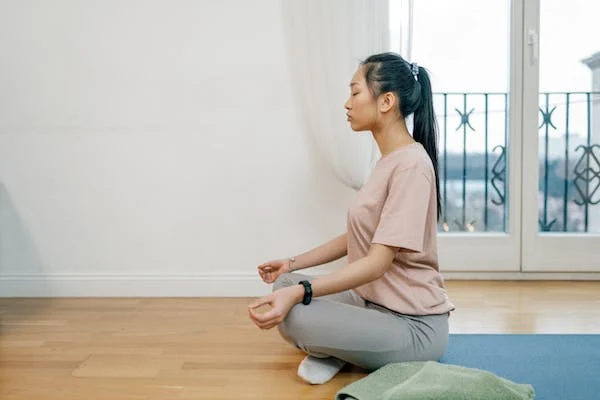When we think of yoga, we often envision contorted bodies and impressive flexibility. However, yoga is much more than just a physical exercise. It is a comprehensive and holistic practice that encompasses the body, mind, and spirit. As someone who has personally experienced the transformative power of yoga, I am thrilled to share my expertise and insights on how beginners can embark on this journey of self-discovery and well-being.
In this blog post, I aim to assist beginners in navigating the world of yoga and ultimately reaping the numerous benefits it offers. So, whether you are a curious beginner eager to explore the world of yoga or someone looking to deepen their existing practice, this blog post is here to guide and inspire you. Join me on this transformative journey as we unlock the secrets of yoga and embark on a path of well-being and self-discovery.
What is yoga?
Yoga, a comprehensive spiritual practice, encompasses various techniques and disciplines that aim to harmonize the mind, body, and spirit, leading to enlightenment and unity with the universe. While the Western perception of yoga primarily revolves around Hatha Yoga, it is important to acknowledge that this is merely one path amongst many. Each path highlights distinct approaches and methods, while ultimately converging on the common objective of unification and enlightenment.
Hatha Yoga, in particular, achieves the integration of mind, body, and spirit through a combination of asanas (yoga postures), pranayama (breathing exercises), mudra (body gestures), and shatkarma (internal purification techniques). These physical practices play a crucial role in purifying the body and nurturing prana (life-force energy). However, contemporary Hatha Yoga places less emphasis on these esoteric practices, focusing primarily on the physical aspect of yoga postures.
Irrespective of your personal objectives or intentions, engaging in yoga postures alone can profoundly benefit both your mental and physical well-being. Embracing these poses offers an exceptional form of exercise that nourishes your body and mind. Whether you aspire to embark on a spiritual journey or simply seek physical fitness, yoga poses serve as a remarkable avenue for self-improvement and holistic growth.
Why You Should Practice Yoga?
Yoga is an ancient Indian physical, mental, and spiritual exercise. Yoga is currently popular not just in India but across the world. It brings your body, mind, and spirit together. When it comes to the benefits of yoga; So it should be practiced regularly. It affects all the elements of our lives, including physical, mental, spiritual, and much more.
At the spiritual level, this unity involves the unification of the individual and the universal consciousness. Also, yoga is a method of practically balancing and adjusting the body, mind, and emotions. Seats, pranayama, mudra, bandha, sat karma, and meditation is all used for this addition or unification. As a result, yoga is both a way of life and the ultimate goal of liberation.
The practice of Yoga regularly has the following benefits:
- Yoga improves strength, balance, and flexibility.
- Yoga helps with back pain relief
- Yoga can ease arthritis symptoms.
- Yoga benefits heart health.
- Yoga relaxes you and helps you sleep better.
- Yoga can mean more energy and brighter moods.
- Yoga helps you manage stress.
The Different Types Of Yoga Poses for Beginners
If you’re new to yoga, it’s a good idea to try out a few different types to see which one is right for you. Here are some popular types of yoga that you can practice today:
Hatha Yoga: Hatha yoga is a slow-paced type of yoga that focuses on holding poses for a long period of time. It’s a great way to learn the basics of yoga and to focus on your breath. You can learn more about how to practice Hatha Yoga from the book Hatha Yoga Pradipika.
Vinyasa Yoga: Vinyasa yoga is a faster-paced type of yoga that focuses on flowing from one pose to the next. It’s a great workout and can help build strength and flexibility.
Ashtanga Yoga: Ashtanga yoga is a very physically demanding type of yoga. It’s best suited for people who are already in good shape and who are looking for a challenging workout.
Iyengar Yoga: Iyengar yoga focuses on the precise alignment of the body. It’s a great way to learn how to do the poses correctly and avoid injury.
Yin Yoga: Yin yoga is a slow-paced type of yoga that focuses on relaxing the body and mind. It’s a great way to de-stress and improve flexibility.
Kundalini Yoga: Kundalini yoga is a type of yoga that focuses on awakening the energy centers of the body. It’s a great way to increase your energy and feel more connected to your body.
Now that you know a little bit about the different types of yoga, it’s time to choose the one that’s right for you. If you’re looking for a challenging workout, try Ashtanga yoga. If you’re looking for a way to de-stress, try Yin yoga. And if you’re looking for a way to increase your energy, try Kundalini yoga.
Since ancient times in India, yoga has been a part of life and the best means to spiritual progress. Yoga Sutra, written by Sage Patanjali, is a piece of literature that can help you learn perfect yoga.
What are the main benefits of yoga practice?
There are several main benefits to yoga. The first benefit of yoga is that it improves the strengths and capabilities of the physical body. Organs, muscles, and nerves do not work in harmony when there is an imbalance at this level; instead, they act in opposition to one another.
Yoga benefits the cerebral, emotional, and physical bodies. As a result of the stress and interactions of regular life, many people suffer from various mental illnesses. Yoga does not bring immediate relief, it is an effective method of dealing with them.
Yoga is an effective therapeutic choice for asthma, diabetes, high blood pressure, arthritis, digestive problems, and other conditions, particularly where contemporary science has failed to provide a cure. HIV (HIV) is now totaling effects based on promising research outcomes.
According to medical professionals, yoga treatment is effective because it restores equilibrium to the neurological and endocrine systems, which directly impacts the body’s other systems and organs.
The Mental Benefits Of Yoga Practice And How It Can Help Improve Your Overall Well-being
Yoga has been shown to be an effective treatment for depression. A study published at Harvard Medical School found that yoga may be as effective as antidepressant medication for people with major depressive disorder. The study showed that people who took part in eight weeks of yoga had significantly lower levels of depression than those who didn’t take part in yoga.
Yoga has also been found to be helpful for people with anxiety disorders. A 2014 study published in The Journal of Clinical Psychiatry found that yoga was as effective as an anti-anxiety medication for people with anxiety disorders. The study showed that people who took part in eight weeks of yoga had significantly lower levels of anxiety than those who didn’t take part in yoga.
How do I practice yoga as a beginner to get the maximum benefits of yoga?
If you’re new to yoga or aren’t very familiar with it, keep the following points in mind:
- Patience and perseverance are keys to a successful yoga practice.
- You may find it challenging to complete most of the asanas at first if you have limited flexibility in your body.
- Do not be concerned if you cannot perform the asanas properly at first. With easy repetitions, everything will get easier.
- The muscles and joints that aren’t stretched as much will grow more flexible over time.
- Do not force or rush your body in any way.
- At first, you should do the asanas that you can readily perform.
The importance of breathwork Yoga for beginners And tips for improving your breathing technique:
When you first start practicing yoga, you may notice that your breath is shallow and erratic. This is perfectly normal. Over time, with regular practice, you will find that your breathing becomes deeper and steadier. The focus on the breath in yoga helps to calm and concentrate the mind, as well as provide numerous other benefits.
Breathwork is an essential part of yoga practice, and there are several techniques that can be used to improve your breathing. One simple way to improve your breathing is to make sure that you are inhaling and exhaling deeply and slowly. Another helpful technique is known as ujjayi breath or ocean breath.
Conclusion:
In conclusion, practicing yoga as a beginner can be a rewarding and transformative experience. By starting slowly, finding the right style and teacher, and listening to your body, you can develop a sustainable and enjoyable practice that enhances both your physical and mental well-being. Remember to be patient with yourself, stay consistent, and, most importantly, have fun exploring the ancient practice of yoga. With dedication and a positive mindset, you will surely reap the numerous benefits that yoga has to offer. Namaste!
The post you may like:
11 Yoga Asanas to increase immunity power
Yoga has a variety of advantages. There is something to suit everyone, from increasing flexibility and strength to decreasing tension and anxiety. So why not get started right away and practice yoga?
DISCLAIMER: THIS WEBSITE DOES NOT PROVIDE MEDICAL ADVICE
The information, including but not limited to, text, graphics, images, and other material contained on this website, is for informational purposes only. No material on this site is intended to be a substitute for professional medical advice, diagnosis, or treatment. Always seek the advice of your physician or other qualified health care provider with any questions you may have regarding a medical condition or treatment before undertaking a new health care regimen, and never disregard professional medical advice or delay in seeking it because of something you have read on this website.


